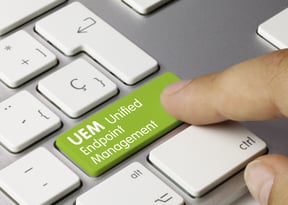Editors note: This blog post is sponsored by IBM, but the content represents my point of view.
You are not going crazy—endpoint management requirements and challenges really are far more complex than they have been since the advent of personal computing in the 1980s. It doesn’t seem all that long ago that enterprises were able to maintain consistent, reliable, and secure end-user computing services across their organizations. However, traditional endpoint management approaches began falling to pieces about a decade ago and continue to be eroded by rapidly evolving business IT requirements. The changes happened so quickly that there is a temptation to attribute them to your favorite conspiracy theory (Is it aliens? A cabal of international rebels? An army of Big Foot cyberterrorists?). The truth is not quite so insidious, but just as impactful to business operations. The chief factors impacting an organization’s ability to effectively manage endpoints can be logically organized into five categories:
#1: Expanding Device Heterogeneity
According to EMA primary research, roughly half of all workers regularly utilize more than one device (including desktops, laptops, tablets, and smartphones) to perform business tasks. These devices employ a diverse range of operating systems (including Windows, macOS, iOS, Android, Linux, and ChromeOS), and each with numerous versions and editions (e.g., there are currently over 250 different flavors of Linux alone). Each disparate endpoint architecture requires a unique set of management capabilities that must collectively be performed in a consistent manner.
#2: Increasing Number of Remote Workers
Portable devices (laptops, tablets, and smartphones) are three times more likely to be used to perform business tasks than non-portable desktops, and only about half of all business tasks are actually performed on the premises of a physical office building. Remote workers are much more difficult to support because administrators are not able to physically access their devices and cannot control the networks over which they communicate. Additionally, remote devices operate at an elevated risk of being stolen, hacked, or otherwise compromised, exposing enterprise data and IT services to potential security breaches.
#3: Distribution of IT Services
Where user software was traditionally installed directly on endpoint devices, today they are widely distributed across public clouds, private clouds, web services, virtual instances, and application hosting environments. In fact, 93% of businesses rely on applications, data, email, and other IT services hosted across multiple environments. Requirements for the delivery, configuration, security, and management of critical business IT resources increase proportionally to the number of independent hosting locations, and unique access and licensing processes needed to be developed for each.
#4: Intensifying Security Risks
EMA research indicates that 73% of businesses are affected by a malware or ransomware attack each year. Additionally, more than 90% of organizations annually experience an access policy violation. Attacks are accelerating both in frequency and effectiveness, and new threats are emerging regularly, such as with the use of targeted malware, cryptojacking, and artificial intelligence.
#5: Expanding User Demands
The “consumerization of IT” led directly to a cultural change in business environments that places user requirements and satisfaction on par with the need to meet business requirements. These changes are commonly reflected in modern-day service-level agreements. Today’s work forces are not shy with requesting the devices, applications, access, and resources they believe they require to most effectively perform their job tasks. Workers are also more tech-savvy then ever before and often insist on the ability to perform certain endpoint management tasks themselves, such as device configuration and application installation. Modern provisioning, management, and security tasks must all accommodate impacts on user experiences.
What Can Be Done?
Fortunately, a number of best practices and solutions have been introduced to directly address modern endpoint management challenges head-on. Collectively, these constitute the key components of unified endpoint management (UEM). Initially introduced to consolidate management for all endpoint device architectures following the introduction of mobile devices into the workplace, UEM evolved to comprehensibly support the breadth of modern end-user computing requirements. In addition to providing centralized administration across the breadth of heterogeneous endpoints, UEM solutions enable advanced security, application, and service management functionality from a single console. Where traditional endpoint management approaches required the purchase of multiple products—for instance, one to support PCs, one to support mobile devices, and another to manage security policies—UEM solutions enable administrators to govern all user devices in exactly the same way using a common asset database and a unified set of user profiles.
Advanced UEM platforms additionally provide features that are specifically designed to improve end-user experiences. For instance, they will include self-service user portals for selecting and installing applications, fully automated remediation tasks to minimize interactions with IT support staff, and integrations with service management and help desk support solutions to ensure all activities are properly logged. Support will also be provided for enabling low-friction identity and access management, with features for or integrations with third-party solutions that enable single-sign on, password vaulting, and/or step-up multifactor authentication. The goal of a UEM platform is to ensure users are eminently productive and satisfied without violating business policies for security and compliance.
EMA research results consistently indicate it is unsustainable to manage modern endpoint management requirements using traditional, distributed administrative practices. By establishing consistency across all endpoint management processes, UEM simplifies administrator tasks, reduces the time it takes to detect and resolve issues, and substantially reduces operational costs. It is not necessary to dig into bizarre conspiracy theories to recognize the dramatic changes that rapidly evolved in end-user computing requirements in recent years. UEM directly addresses these challenges, enhancing business performance, user experiences, and security assurance.
For more information on how to achieve comprehensive UEM with IBM, request a demo here.





